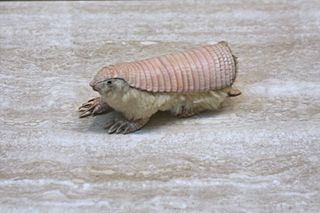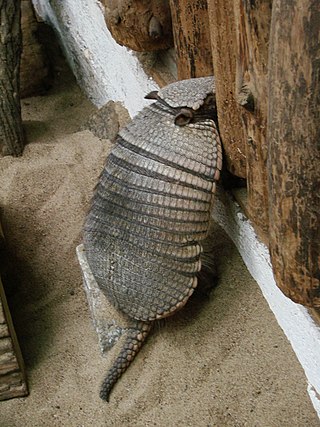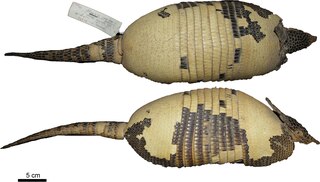
Armadillos are New World placental mammals in the order Cingulata. The Chlamyphoridae and Dasypodidae are the only surviving families in the order, which is part of the superorder Xenarthra, along with the anteaters and sloths. Nine extinct genera and 21 extant species of armadillo have been described, some of which are distinguished by the number of bands on their armor. All species are native to the Americas, where they inhabit a variety of different environments.

Xenarthra is a major clade of placental mammals native to the Americas. There are 31 living species: the anteaters, tree sloths, and armadillos. Extinct xenarthrans include the glyptodonts, pampatheres and ground sloths. Xenarthrans originated in South America during the late Paleocene about 60 million years ago. They evolved and diversified extensively in South America during the continent's long period of isolation in the early to mid Cenozoic Era. They spread to the Antilles by the early Miocene and, starting about 3 Mya, spread to Central and North America as part of the Great American Interchange. Nearly all of the formerly abundant megafaunal xenarthrans became extinct at the end of the Pleistocene.

The pink fairy armadillo is the smallest species of armadillo, first described by Richard Harlan in 1825. This solitary, desert-adapted animal is endemic to central Argentina and can be found inhabiting sandy plains, dunes, and scrubby grasslands.

The giant armadillo, colloquially tatu-canastra, tatou, ocarro or tatú carreta, is the largest living species of armadillo. It lives in South America, ranging throughout as far south as northern Argentina. This species is considered vulnerable to extinction.

Cingulata, part of the superorder Xenarthra, is an order of armored New World placental mammals. Dasypodids and chlamyphorids, the armadillos, are the only surviving families in the order. Two groups of cingulates much larger than extant armadillos existed until recently: pampatheriids, which reached weights of up to 200 kg (440 lb) and chlamyphorid glyptodonts, which attained masses of 2,000 kg (4,400 lb) or more.

The six-banded armadillo, also known as the yellow armadillo, is an armadillo found in South America. The sole extant member of its genus, it was first described by Swedish zoologist Carl Linnaeus in 1758. The six-banded armadillo is typically between 40 and 50 centimeters in head-and-body length, and weighs 3.2 to 6.5 kilograms. The carapace is pale yellow to reddish brown, marked by scales of equal length, and scantily covered by buff to white bristle-like hairs. The forefeet have five distinct toes, each with moderately developed claws.

The southern naked-tailed armadillo is a species of small armadillo from South America.

The seven-banded armadillo, also known as the Brazilian lesser long-nosed armadillo, is a species of armadillo from South America found in Paraguay, Argentina, Bolivia and Brazil. It is a solitary nocturnal, terrestrial animal, living mostly in dry habitats, outside of rainforest regions.

The greater naked-tailed armadillo is an armadillo species from South America.

The southern long-nosed armadillo is a species of armadillo native to South America.

The southern three-banded armadillo, also known as La Plata three-banded armadillo or Azara's domed armadillo, is an armadillo species from South America. It is found in parts of northern Argentina, southwestern Brazil, Paraguay and Bolivia, at elevations from sea level to 770 m (2,530 ft).

The pichi, dwarf armadillo or pygmy armadillo is an armadillo native to Argentina. It is the only living member of the genus Zaedyus, and the only armadillo to hibernate.

The northern naked-tailed armadillo is a species of armadillo. It is one of only two species of armadillo found outside of South America, the other being the more widely distributed nine-banded armadillo.

The bighairy armadillo is one of the largest and most numerous armadillos in South America. It lives from sea level to altitudes of up to 1,300 meters across the southern portion of South America, and can be found in grasslands, forests, and savannahs, and has even started claiming agricultural areas as its home. It is an accomplished digger and spends most of its time below ground. It makes both temporary and long-term burrows, depending on its food source.

The greater fairy armadillo, also known as Burmeister's armadillo or the Chacoan fairy armadillo, is a species of armadillo in the family Chlamyphoridae. It is found in Argentina, Bolivia, and Paraguay. Its natural habitats are subtropical or tropical dry shrubland and subtropical or tropical dry lowland grassland. It is threatened by habitat loss and persecution. It is the only species in the genus Calyptophractus.

The hairy long-nosed armadillo or woolly armadillo is a species of armadillo in the family Dasypodidae. It is endemic to Peru. Its natural habitats are subtropical or tropical moist lowland forest and subtropical or tropical moist montane forest. The International Union for Conservation of Nature used to consider it a "vulnerable species" but has changed this assessment to "data deficient" because so little is known about the animal and the threats it faces.

Yepes's mulita or the Yungas lesser long-nosed armadillo is a species of armadillo in the family Dasypodidae. It is endemic to Argentina and Bolivia. Its natural habitat is subtropical dry forests. The species was renamed D. yepesi because the type of D. mazzai was suspected to correspond of other species of Dasypus, which it was later proved wrong, becoming D. yepesi a synonym of D. mazzai.

Chlamyphoridae is a family of cingulate mammals. While glyptodonts have traditionally been considered stem-group cingulates outside the group that contains modern armadillos, there had been speculation that the extant family Dasypodidae could be paraphyletic based on morphological evidence. In 2016, an analysis of Doedicurus mtDNA found it was, in fact, nested within the modern armadillos as the sister group of a clade consisting of Chlamyphorinae and Tolypeutinae. For this reason, all extant armadillos but Dasypus were relocated to a new family.


















